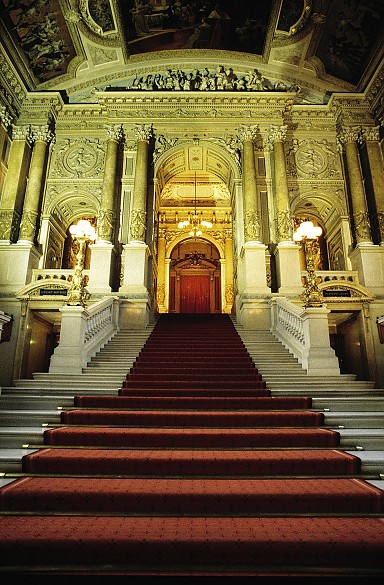Buried alive? The new Burgtheater on Vienna’s Ringstrasse
Two days after the farewell performance in the old theatre on Michaelerplatz the new theatre on the Ring was opened. Despite certain deficiencies in its construction, it soon became a meeting-place for Viennese society.
The actor Hugo Thimig (1854–1844) on the Burgtheater on the RingstrasseWe are now irretrievably stuck in the new grandiose crypt of our Burgtheater and watch, in an agony of fear, buried alive, as the dear old house on Michaelerplatz is slowly and relentlessly demolished. For a short time we will live off our old glory, and then the curse of this huge new theatre will have destroyed all our good traditions.
The Neue Freie Presse passed a devastating judgement on the failings in the Burgtheater’s design.If the Burgtheater, this incomparable ornament of Vienna, is to be saved, the most energetic measures must be taken: either a new theatre should be built cheaply, or the existing auditorium of this disastrous theatre must be so thoroughly rebuilt that not a stone is left standing.
The basic problem of the theatre during that time was summarized succinctly by Baron Alfred von Berger, manager from 1910 to 1912.The Burgtheater is an insoluble problem. As it is an artistic institution it must stand under the banner of freedom; because it is a court institution, it is tied. The squaring of the circle, perpetual motion and an ideal Burgtheater manager – these are three equally insoluble problems.
Well before midday, queues had formed outside the new theatre in the hope of obtaining tickets for the opening performance. When the box office opened at six o’clock in the evening, chaos broke out – some fell and many were injured in the crush but still failed to get their hands on tickets. The opening evening became a showcase of Viennese high society, which paraded through the spacious foyer and up the sweeping staircases.
The theatre was designed in neo-Baroque style by Gottfried Semper, who was responsible for the ground plan, and Carl Hasenauer, who designed the façade. Construction had started in 1874 and taken over fourteen years to complete.
The theatre was lavishly decorated. The ceiling frescos above the two stairwells were painted by the 24-year-old Gustav Klimt together with his younger brother Ernst and fellow-student from the Academy, Franz Matsch. The three young artists had formed an ‘artists’ company’ and had already executed several similar commissions in the Crown Lands. Now they had the opportunity of showing off their talents in the imperial capital for the first time, and in a highly prominent place at that.
Its imposing design and magnificent decoration paired with technical innovations – the Burgtheater was the first monumental building to have electric lighting, initially made it popular with the public. However, the poor acoustics and deficiencies in the stage machinery soon made themselves noticeable and in 1897 the auditorium had to be remodelled.
The actors were apprehensive about the huge interior. Only by enunciating clearly and using vigorous delivery could they be understood by audiences.
After a series of alterations the ‘Burg’ became a much-frequented meeting-place for Viennese society and established its claim to be the ‘foremost German stage’. Besides classics and German comedies it also included more recent, socially critical works in its repertoire.
The first play by Arthur Schnitzler to be performed was Liebelei. In 1901 Lumpazivagabundus became the first play by the popular playwright Johann Nestroy to be performed at the Burgtheater. However, there were only two further performances. Like Raimund, Nestroy was not considered suitable fare by the theatre’s audiences.























